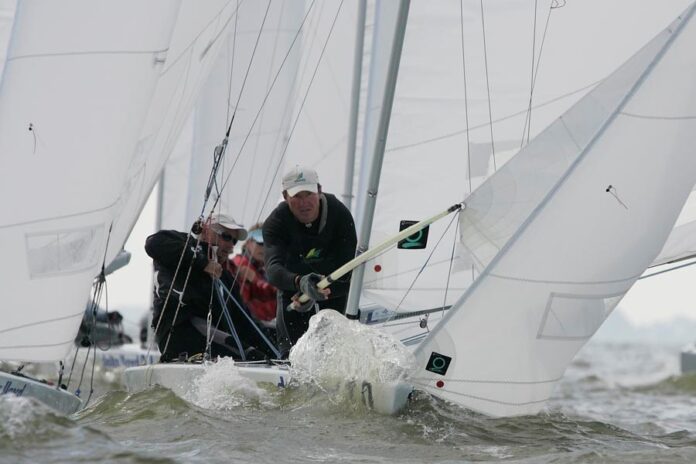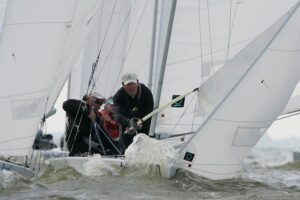

Part Two – Wind Weather and Currents – following on from the recent blog from the interview with Andrew Palfrey. Andrew is better known to the worldwide yachting fraternity as “Doggy”. He will give us the benefit of his vast experience in factoring wind, weather, and currents into sailing and its importance in planning the conduct of your race. Understanding these elements can be as crucial as seeking expert advice when tackling complex tasks, much like those faced by a ghostwriting masterarbeit professional, who must account for every detail in their research and planning to ensure success.
This is part two in a series of excerpts from an interview I did with the high-achieving sailor, Olympian and coach.
FREE BOOK – TIPS FROM SAILING LEGENDS
Brett: How do you call wind shifts and what feedback do you want from your crew? How do you handle communication in the boat?
Andrew: I might take a little bit of a different path here, because I reckoned you hit on something that’s ultra-ultra-important and that something that people struggle to get right, and it’s taken me many, many years to kind of think about and work on.
Who in the team is strong at what?
Where do people’s strengths lie? But also, playing your role and supporting those around you. And it all sounds pretty airy-fairy and fluffy, but what it really means is…
I’ll give you an example. When I was sailing with Iain Murray in the Star, we had it pretty well worked out, what he was responsible for, what I was responsible for, and where the overlaps were.
And to start with, we were very weak tactically. And it took a few days of sailing together to kind of put the finger on what was going on. I think what was happening is, from our side…but we hadn’t spoken about it, that was the key.
Leading up to the Olympic Stars, Iain and I sailed an Etchells with Michael Coxon to get some high-quality fleet racing experience.
But from our side, Iain and I’s side, we’re kind of probably thinking subconsciously, “Well, he’s Cocko. He’s one of the best tacticians going around.” Well, he used to do the tactics. And I’ll call the wind and Iain can do his thing at the back of the boat.
Cocko, it turns out, was thinking, “Well, hang on, these two guys are embarking on an Olympic campaign, they probably don’t want me to do too much or say too much. I’ll kind of let them do their thing and I’ll trim the main.”
Crew Discussion
And basically, what would happen, we had really good discussions before the start, but as we approached times where decisions had to be made, we weren’t making the decisions. It was all too…there was too much decision by committee.
We were just, we were doing some really silly things, tactically, which was having quite a big effect on our races.
So I think I said to Cocko something along the lines of, “Look, I’m here to help. You’re the tactician. And it’s not a democracy, it’s not a committee. Decisions have to be made. You’re not going to be second-guessed, we’re all behind you.
So make the decisions, be clear, and if you do the exact opposite of the picture I’ve just painted, that’s 100% fine. There’s no problem at all. I’m happy with that.
You make the decisions and we can review it later over a beer that night. Why did you want to go that way when da da da?… But there’s not going to be bad feelings at the time, there’s not going to be second-guessing, and let’s just get on with it.”
And from that point, we turned it around. And I learned a lot from that and I’ve since had that discussion, I have that discussion with pretty much everyone I sail with.
Crew Responsibilities
With that comes core responsibilities which, on that side of things, the calling the wind, short-term, having a view of the wind, long-term, and helping make decisions into the top mark and bottom mark based on what we’re seeing up the track.
So do we gybe or do we go straight out of the top mark? That sort of thing. So when I sail, that’s the way we work. It’s one guy’s responsible for the wind, one guy’s responsible for tactics and strategy and the helmsman, we generally try and leave him to steer because as we know, that’s a damn hard job to do well.
-
Brett: Do you take notice of clouds on the course and how do they affect your decision-making?
Andrew: Yes, for sure, for sure. I think they’re definitely a big part of the overall picture.
And so, like I said in the e-mail, it might be as basic as just helping you figure out when a thermal breeze is setting up. Like, seeing the cumulus develop over the land, let’s say, just an indicator there’s some convection there and the sea breeze is setting up, which maybe, quite, might not really have an impact.
If the wind’s offshore and it’s weakening, that could say, well, this is going to happen in a hurry. Or it could be that it’s a squally day and the clouds are coming through pretty quickly and there might be a bit of rain in them or that cold air falling out of them for sure, I think they’re going to have a much bigger effect on your mindset and your game plan, or things like that.
Or it may well be there’s a change in the weather system driven by the synoptic situation and you sort of see some high cloud coming across that you’d seen in the morning in the weather, and that’s indicating to you that big picture, “Okay, that’s signifying that the gradient winds going to move a little one way or the other,” that you’d seen that morning.
So I think these things are triggers, to me, anyway.
FREE BOOK – TIPS FROM SAILING LEGENDS
Brett: If a front is predicted during a race, does your strategy take this into account?
Andrew: Yeah, absolutely. I have a bit of a routine on a race day which… I quite like getting up early so I’ve got the time to sift through the internet and the weather and so on.
It just goes in, it’s just sort of in there, back of mind. Then, there’s some recall through the day if it does play out the way you had seen it that morning.
And to the person that’s only gone into one layer, just the numbers, is going to be hedging pretty hard right. But the person who’s done a bit more homework will look up the track and say, “Well, there’s no cloud.” That cloud’s not in evidence.
That was the thing that was going to drive it to go one way or the other. So then, half the fleet is jammed up against the windward end of the start line, half of them getting crappy starts because they think they want to go right.
Whereas, the people that dug another level, they’re getting nice starts a little way down the line and no hurry to tack. And all of a sudden, it didn’t go right. You’ve invested all that risk in something that didn’t happen.


